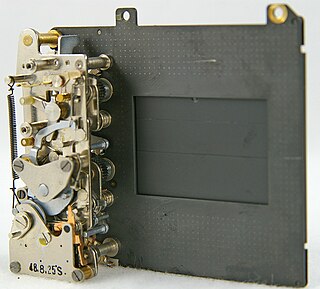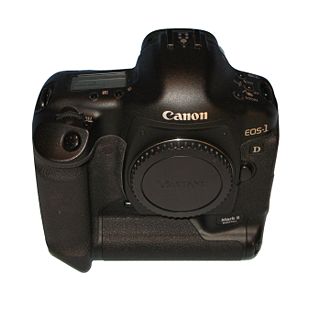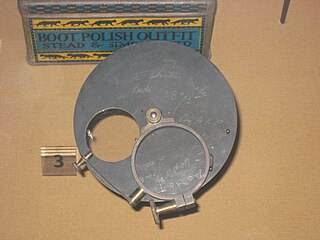
A camera is an instrument used to capture and store images and videos, either digitally via an electronic image sensor, or chemically via a light-sensitive material such as photographic film. As a pivotal technology in the fields of photography and videography, cameras have played a significant role in the progression of visual arts, media, entertainment, surveillance, and scientific research. The invention of the camera dates back to the 19th century and has since evolved with advancements in technology, leading to a vast array of types and models in the 21st century.

In photography, shutter speed or exposure time is the length of time that the film or digital sensor inside the camera is exposed to light when taking a photograph. The amount of light that reaches the film or image sensor is proportional to the exposure time. 1⁄500 of a second will let half as much light in as 1⁄250.

In camera design, a focal-plane shutter (FPS) is a type of photographic shutter that is positioned immediately in front of the focal plane of the camera, that is, right in front of the photographic film or image sensor.
Cinema Products Corporation was an American manufacturer of motion picture camera equipment.

A rotary disc shutter is a type of shutter. It is notably used in motion picture cameras. Rotary shutters are semicircular discs that spin in front of the film gate, alternately allowing light from the lens to strike the film, or blocking it.

Panavision is an American motion picture equipment company founded in 1954 specializing in cameras and lenses, based in Woodland Hills, California. Formed by Robert Gottschalk as a small partnership to create anamorphic projection lenses during the widescreen boom in the 1950s, Panavision expanded its product lines to meet the demands of modern filmmakers. The company introduced its first products in 1954. Originally a provider of CinemaScope accessories, the company's line of anamorphic widescreen lenses soon became the industry leader. In 1972, Panavision helped revolutionize filmmaking with the lightweight Panaflex 35 mm movie camera. The company has introduced other cameras such as the Millennium XL (1999) and the digital video Genesis (2004).

The EOS 1D Mark II is a professional 8.2 megapixel digital single lens reflex camera (DSLR) camera body produced by Canon. The EOS 1D Mark II was the successor of the EOS 1D and was itself replaced by the Canon EOS-1D Mark III in 2007. It was Canon's first dual-card slot EOS camera with one CF slot and one SD slot that was meant easily to use two dominant card types and have a assurance that once a small sized primary and faster CF slot is full, camera can be used to take photographs when recording was continued on secondary and slower card in critical moment. It also now had wireless capabilities. When paired with the new Canon WFT-E1, you could transfer images to a PC using an FTP server.

In photography, a shutter is a device that allows light to pass for a determined period, exposing photographic film or a photosensitive digital sensor to light in order to capture a permanent image of a scene. A shutter can also be used to allow pulses of light to pass outwards, as seen in a movie projector or a signal lamp. A shutter of variable speed is used to control exposure time of the film. The shutter is constructed so that it automatically closes after a certain required time interval. The speed of the shutter is controlled either automatically by the camera based on the overall settings of the camera, manually through digital settings, or manually by a ring outside the camera on which various timings are marked.

The Genesis is a discontinued high-end digital movie camera developed by Panavision, and was available solely by rental. It is based on a proprietary Super 35 1.78:1 (16:9) aspect ratio, 12.4-megapixel, RGB filtered CCD sensor. It was first used by a feature crew to shoot Bryan Singer's Superman Returns, and was shortly followed up thereafter by the World War I film Flyboys. However, the computer effect-heavy nature of these two movies meant that ultimately the comedy Scary Movie 4 was the first theatrically released feature primarily shot with the Genesis. It was discontinued in 2012 and succeeded by the Millennium DXL line developed with Red Digital Cinema.

High-speed photography is the science of taking pictures of very fast phenomena. In 1948, the Society of Motion Picture and Television Engineers (SMPTE) defined high-speed photography as any set of photographs captured by a camera capable of 69 frames per second or greater, and of at least three consecutive frames. High-speed photography can be considered to be the opposite of time-lapse photography.
Super Panavision 70 is the marketing brand name used to identify movies photographed with Panavision 70 mm spherical optics between 1959 and 1983. It has since been replaced by Panavision System 65.
The Arriflex 435 is a movie camera product line created by Arri in 1995 to replace the Arriflex 35-III line. The number reflects its position as a successor camera to the Arri III and the fact that it is designed for 35 mm film. The 435 cameras are specifically designed as MOS cameras, which means that they are conventionally considered to be too loud to record usable location sound. However, this also frees the camera up to be optimized for non-sync sound uses, particularly any filming which either doesn't require sound or shooting at non-sync speed, shooting in reverse, or ramping between different speeds. As such, its potential applications are widespread, and thus it is regularly used on music videos, commercials, second unit work on features, special effects work, and motion control, among other usage. Rival Panavision even owns more 435s for rental than Arri's own hire houses; Panavisions, however, can be converted to Pan-Arri 435s where they are modified to accept Panavision lenses and accessories. In recognition of the achievements of the 435 system, AMPAS awarded Arri a Scientific and Engineering Academy Award in 1999.

Ultra Panavision 70 and MGM Camera 65 were, from 1957 to 1966, the marketing brands that identified motion pictures photographed with Panavision's anamorphic movie camera lenses on 65 mm film. Ultra Panavision 70 and MGM Camera 65 were shot at 24 frames per second (fps) using anamorphic camera lenses. Ultra Panavision 70 and MGM Camera 65's anamorphic lenses compressed the image 1.25 times, yielding an extremely wide aspect ratio of 2.76:1.
This article summarized the comparison of movie cameras.
The Arriflex 35, released by Arri in 1937, was the first reflex 35mm production motion picture camera.

The Arriflex 16ST, also Arriflex 16S, is a 16mm MOS production motion picture camera released in 1952 by ARRI. The camera utilizes a voltage of 8.4 volts DC
The Arriflex 16BL is ARRI's first silent 16mm production motion picture camera, released in 1965. It was replaced by the Arriflex 16SR in 1975.
The Arriflex 35BL is a 35mm motion picture camera released by ARRI in 1972.
The Arriflex 765 is a 65 mm movie camera created by Arri in 1989.












